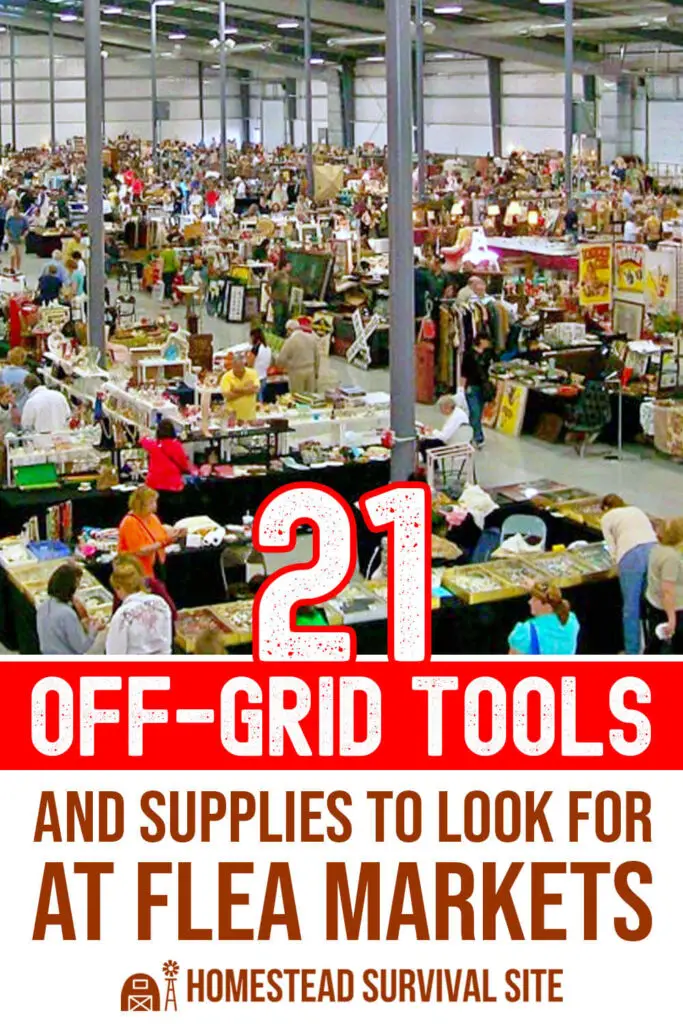Estimated reading time: 6 minutes
If you want to get some great bargains for your homestead, it’s time to start visiting flea markets. Flea markets get their name from “marché aux puces,” a French phrase that literally translates to “market of fleas.” The name comes from the fact that the first outdoor bargain markets in Paris often included items that were old and worn and possibly full of fleas.
Today’s flea markets, however, feature a wide variety of quality second-hand clothing, household supplies, and equipment that can save you a bundle. It’s worth the time to visit your local flea markets on a regular basis to look for things that can make your homesteading life easier or more convenient at a fraction of what they would cost new.
Here is our list of items to put on your flea market checklist.
Want to save this post for later? Click Here to Pin It On Pinterest!
1. Books
From oldie but goodie cookbooks to novels to DIY guides to school books for the kids, flea markets can have great reading selections. Quality hardcover books are often priced at $1 or less.
2. Storage Containers
Baskets, buckets, wooden boxes, barrels and other containers can come in handy around your homestead. Flea markets are often full or attractive, useful storage options at great prices. Some vintage containers are so decorative, they can double as home décor pieces as well as being useful.
3. Furniture
Well-made furniture never goes out of style. You can find bargains on tables, chairs, bookshelves, and cabinets at flea markets. Outdoor furniture can double your living space in nice weather.
4. Canning Jars
Whether you use them for food preservation, as drinking glasses, as vases or for other purposes around the homestead, sturdy glass canning jars are usually plentiful at flea markets. It’s not unusual to find them priced at around $3 for a dozen jars.
5. Lamps and Candles
You often can find new or almost new candles at giveaway prices at flea markets. Kerosene lamps are another useful find for the prepared homesteader.
6. Fabric
Curtains, bedspreads, blankets, and sheets can be used as is or repurposed in a variety of ways for your home and property.
Want to start a homestead but not sure how?
Click Here to get a FREE book, "How To Homestead No Matter Where You Live."
7. Old Windows, Ladders, and Doors
These items can be refinished and repainted for use in your home, your outbuildings or even as charming garden décor. For example, an old ladder can become a plant stand indoors or outdoors. A door can be part of a sturdy and attractive table, and a window can work well in a chicken coop. You also can repurpose shutters for vertical gardening.
8. Large Buckets, Sinks, and Tubs
These items can be used as water and feed troughs for your animals, as planters in your garden or as containers for any number of homestead supplies.
9. Toys, Games, and Puzzles
You and your family can spend many happy hours playing games and puzzles that you purchase inexpensively from flea markets. Chances are good your kids will find a fun toy or two to keep them entertained – at least for a while.
10. Tools
Check flea markets frequently for low prices on well-made, brand-name tools to add to your home and garden collection. Battery-operated tools are a great find. Also look for nails, screws, and bolts at very low prices.
11. Appliances
You might pick up a great deal on large home appliances such as a washing machine or a dishwasher. Check these machines out carefully to make sure they are in good operating order before purchasing, however.
Also keep an eye out for quality smaller appliances such as food processors, bread machines, ice cream makers, crockpots, dehydrators, grain mills and coffee grinders. Hand-operated machines are good choices for homesteaders who live off the grid.
12. Baby Equipment
You may find gently-used strollers, baby beds, playpen, baby carriers and other items for your little ones at a flea market.
13. Shoes and Clothing
Are your kids growing out of everything? Are you spending more time than ever outdoors? Look for big savings on clothing, coats, hats, gloves, shoes, and boots.
14. Sewing Items
Flea markets can have incredible prices on thread, patches, yarn, needles, fabric, patterns and even sewing machines.
15. Camping Gear
Tents, tarps, sleeping bags, cook stoves and cast-iron pots are important pieces for a homesteader to own. Yet, they are pricey when purchased new. Look for quality used items at flea markets that still have years of service left in them.
16. Bicycles
Bikes and exercise equipment frequently find their way to flea markets. Be sure to ask to take a bicycle out for a test drive before purchase.
17. Pet Supplies
The cost of owning pets can skyrocket if you buy new supplies. Visit flea markets for good prices on pet leashes, harnesses, collars, kennels and crates.
18. Gardening Supplies
From old-fashioned hand tools to terracotta pots, you can often find durable gardening items at flea markets. Vintage watering cans, seed trays, and gardening gloves, among other items, can be discovered at a fraction of the price of new ones. If you’re lucky, you might even come across some heirloom seeds!
Want to start a homestead but not sure how?
Click Here to get a FREE book, "How To Homestead No Matter Where You Live."
19. Vintage Radios and Communication Devices
Classic radios, particularly those that are hand-crank or battery-operated, can be valuable assets when living off the grid. They not only provide entertainment but can also be crucial in times of emergency for receiving updates. Additionally, CB radios or walkie-talkies might be available, aiding in remote communication.
20. Handmade Quilts and Blankets
Handcrafted textiles often find their way to flea markets. These pieces are not only beautiful but also hold a rich history and are often much warmer and more durable than factory-made blankets. They can be utilized for bedding, cozying up on cold nights, or even as decorative wall hangings.
21. Manual Kitchen Gadgets
In the days before electric appliances became commonplace, many kitchen tasks were performed using hand-powered devices. From hand-cranked egg beaters to manual coffee grinders, these gadgets are built to last. They’re especially handy for off-grid living, where electricity might be a luxury.
Be Ready to Haggle
Prices at flea markets are negotiable, and many people find that the bargaining process is part of the fun of flea market shopping. To get the best deals, here are a few tips:
- Arrive early at the sale to see full selection.
- Bring cash.
- Don’t be afraid to ask questions.
- Bundle items together for lower pricing.
- Treat vendors with courtesy.
- Vendors may be willing to offer better deals near closing time.
Have you ever found an incredible deal at a flea market? Comment below and tell us about it!
Like this post? Don't Forget to Pin It On Pinterest!





Leave a Reply